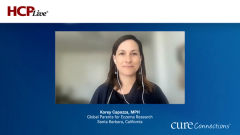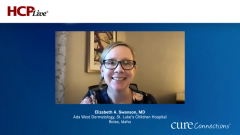
Approaching the Management of Atopic Dermatitis
Raj J. Chovatiya, MD, PhD, discusses the level of awareness of atopic dermatitis within the medical community and approaching the management of disease.
Episodes in this series

Raj J. Chovatiya, MD, PhD: This speaks to, some of the difficulties or challenges we have in terms of actual awareness with atopic dermatitis in the medical community. In terms of, what is this condition? Who’s getting it? What does it look like? Is it something that’s going to stick around for a few months? Is it going to go on for a long time? We have answers to some of these questions, but a lot of them, we don’t. That’s been a heavy focus on a lot of research and I hope it’s going to continue to be going forward. We already realized in hearing Taylor’s story that patients will seek care at a lot of different times, sometimes early on. They’ll go to a generalist and hopefully the generalist is going to recognize the signs and symptoms of atopic dermatitis and provide appropriate guidance. That isn’t always the case. In childhood, oftentimes the pediatrician is the first one fielding that before it ends up going to a specialist, particularly for people to moderate to severe disease. Education, particularly toward pediatricians, is so important in terms of what we’re looking for, what are good recommendations. As adults, people might end up going to their primary care doctor. Some people go to the dermatologist directly or other physicians as well. I think that there’s so much heterogeneous knowledge across groups that, if we could bring everyone up to the same level playing field, perhaps we wouldn’t have delayed diagnoses or missed diagnoses. Or people saying you’ll grow out of this, don’t worry about it, moisturize more often. If that’s the case, then there’s an entire trickle-down effect on improving patient quality of life, caregiver quality of life. You’re lowering health costs. You’re reducing the burden on the health care system. Conversations like this, and educational efforts are one big way we can make that happen.
I want to shift gears for a second and talk about the approach to managing atopic dermatitis. Taylor brought this up earlier about thinking about treating the symptoms. Thinking about the root cause of the disease and how we approach it. What I’ll do is, I’ll walk us through our typical paradigm, and then I’d love to have Elizabeth chime in on thoughts that she has, particularly as it relates across age groups. To make sure we’re talking the same language, there’s a variety of guidelines out there. There’s guidelines that the American Academy of Dermatology has, the European Task Force on Atopic Dermatitis, there’s other societies around the world. They largely agree on several things. With atopic dermatitis, we think of a stepwise care model. Usually looking at people with milder disease, more moderate disease, and severe disease. As I alluded to earlier with pathophysiology, a lot of our treatments are centered around helping to fix and repair the barrier, helping to control inflammation. For a lot of people with this milder form of atopic dermatitis, simple stuff like avoiding triggers, optimizing bathing, making sure the water is not too hot, not using irritants, and then moisturizing, finding the right moisturizer and doing it regularly, can be enough. It’s when people move beyond this point to atopic dermatitis that’s not responding, we start thinking about some of the therapies that we heard about. Topical therapies are a mainstay of mild and moderate disease. This includes topical anti-inflammatory therapies. Topical corticosteroids are the most readily available, cheapest, and most common ones prescribed, but there’s others that are out there. There’s topical calcineurin inhibitors. A topical phosphodiesterase-4 inhibitor. All of which can be used in a proactive and reactive manner, depending on the disease. Typically, when these aren’t working, the next things we start thinking about are systemic therapies. This includes things that are not working from the outside in, but things that are working from the inside out. There are oral therapies. There’s light-based therapies. There’s injectable therapies. And there’s different considerations for when we would want to use these. Oftentimes, these are even used in combination, depending on what’s going to work best for the patient.
Transcript Edited for Clarity
Newsletter
Access practical, evidence-based guidance to support better care for our youngest patients. Join our email list for the latest clinical updates.





